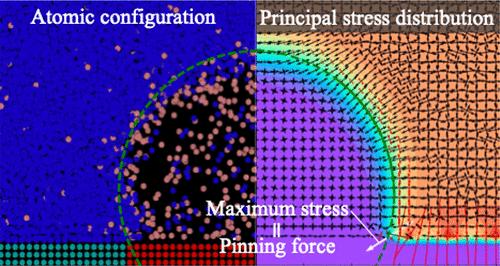Our official English website, www.x-mol.net, welcomes your feedback! (Note: you will need to create a separate account there.)
Molecular Dynamics Study of the Microscopic Mechanical Balance at the Three-Phase Contact Line of Interfacial Nanobubble
Langmuir ( IF 3.9 ) Pub Date : 2024-04-11 , DOI: 10.1021/acs.langmuir.3c04027 Yusuke Jonosono 1 , Shin-ichi Tsuda 2 , Takashi Tokumasu 3 , Hiroki Nagashima 1
Langmuir ( IF 3.9 ) Pub Date : 2024-04-11 , DOI: 10.1021/acs.langmuir.3c04027 Yusuke Jonosono 1 , Shin-ichi Tsuda 2 , Takashi Tokumasu 3 , Hiroki Nagashima 1
Affiliation

|
This study reveals the microscopic mechanical balance at the three-phase contact line (TPCL) of an interfacial nanobubble on a substrate with a wettability pattern using molecular dynamics simulations. The apparent contact angle was compared to that evaluated using Young’s equation, in which the interfacial tensions were computed using a mechanical route. The comparison was conducted by changing the wettability of the substrate from hydrophilic to neutral while maintaining a hydrophobic region in the center of the substrate. When the wettability pattern pins the TPCL at the wettability boundary, the contact angle computed by Young’s equation is larger than the apparent contact angle because a pinning force exists in the inward direction of the nanobubble. Conversely, on the surfaces where the wettability pattern does not pin the TPCL, the contact angle computed by Young’s equation agrees with the apparent contact angle because the pinning force disappears. The distribution of principal stresses around the TPCL, which was visualized for the first time in this study, indicates that large compressive principal stresses exist between the liquid phase and the solid substrate interface, which pin the TPCL at the surface wettability boundary, and that the maximum principal stress occurs in the inward direction of the nanobubbles at the TPCL. The normalized pinning force estimated from the maximum principal stress is equivalent to that measured experimentally.
中文翻译:

界面纳米气泡三相接触线微观机械平衡的分子动力学研究
这项研究利用分子动力学模拟揭示了具有润湿性模式的基底上界面纳米气泡的三相接触线(TPCL)处的微观机械平衡。将表观接触角与使用杨氏方程评估的接触角进行比较,其中界面张力是使用机械途径计算的。通过将基材的润湿性从亲水性改变为中性,同时保持基材中心的疏水性区域来进行比较。当润湿性图案将TPCL钉在润湿性边界时,由杨氏方程计算的接触角大于表观接触角,因为纳米气泡的向内方向存在钉扎力。相反,在润湿性图案未钉扎 TPCL 的表面上,由于钉扎力消失,由杨氏方程计算的接触角与表观接触角一致。本研究首次将 TPCL 周围的主应力分布可视化,表明液相与固体基质界面之间存在较大的压主应力,将 TPCL 固定在表面润湿性边界处,并且最大主应力出现在 TPCL 处纳米气泡的向内方向。根据最大主应力估算的归一化钉扎力相当于实验测量的值。
更新日期:2024-04-11
中文翻译:

界面纳米气泡三相接触线微观机械平衡的分子动力学研究
这项研究利用分子动力学模拟揭示了具有润湿性模式的基底上界面纳米气泡的三相接触线(TPCL)处的微观机械平衡。将表观接触角与使用杨氏方程评估的接触角进行比较,其中界面张力是使用机械途径计算的。通过将基材的润湿性从亲水性改变为中性,同时保持基材中心的疏水性区域来进行比较。当润湿性图案将TPCL钉在润湿性边界时,由杨氏方程计算的接触角大于表观接触角,因为纳米气泡的向内方向存在钉扎力。相反,在润湿性图案未钉扎 TPCL 的表面上,由于钉扎力消失,由杨氏方程计算的接触角与表观接触角一致。本研究首次将 TPCL 周围的主应力分布可视化,表明液相与固体基质界面之间存在较大的压主应力,将 TPCL 固定在表面润湿性边界处,并且最大主应力出现在 TPCL 处纳米气泡的向内方向。根据最大主应力估算的归一化钉扎力相当于实验测量的值。



























 京公网安备 11010802027423号
京公网安备 11010802027423号